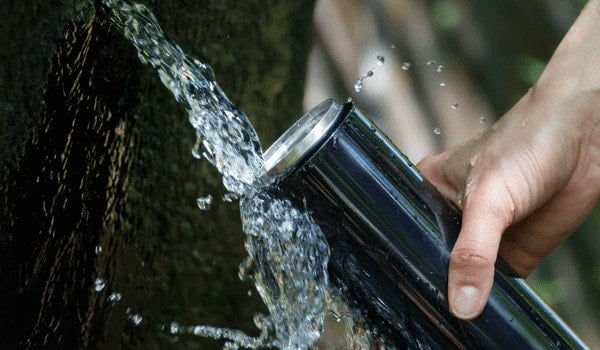
Let’s be real — if your water tastes like metal, mildew, or a hint of swimming pool, it’s hard to get excited about drinking it. You’re not alone. A surprising number of people are reaching for bottled water just to avoid that funky tap flavor.
But here’s the good news: you don’t need to stockpile plastic bottles to fix it. A few smart tweaks — from simple DIY tricks to budget-friendly filters — can make your tap water actually taste good.
So before you give up on your faucet, here’s how to freshen up what’s flowing from it.
🔑 Key Takeaways
- 🍋 Citrus, mint, and fruit are easy ways to add natural flavor and cut weird aftertastes.
- 🧊 Cold water tastes better. Chill it or add ice to smooth out funky notes.
- 🧪 Bad taste can be a sign of excess chlorine, sulfur, or metal — a filter can fix that.
- 🧼 Activated carbon is best for chlorine; reverse osmosis is ideal for metals and minerals.
- ♻️ Skip bottled water — home filters are cheaper, greener, and just as effective.
💡 Pro Tip: Letting water sit out for a few hours helps chlorine evaporate naturally — no filter needed.
😖 Why Does Tap Water Taste Off?

If your tap water tastes like a swimming pool or smells like rotten eggs, you’re not imagining things. The flavor and aroma of your water come down to what’s dissolved in it — and not all of it is welcome.
Here’s a quick breakdown of what might be messing with the taste:
- 🧪 Chlorine: Used to kill bacteria in public water systems, chlorine leaves a strong chemical aftertaste. Think “public pool,” but in your cup.
- 🥚 Hydrogen Sulfide: That rotten egg smell? Classic hydrogen sulfide. It’s common in well water and can be overwhelming in high amounts.
- 🛠️ Iron & Copper: Metallic tastes usually come from plumbing. Iron can give water a rusty flavor, while copper from aging pipes may leave a bitter tang — plus blue-green stains around faucets.
- 🌱 Sediment & Organic Matter: If your water tastes earthy or swampy, it may contain bits of decaying leaves or silt — especially common with surface-sourced supplies or private wells.
- 🧂 Hard Minerals: Calcium and magnesium add body to your water. A little is fine — too much, and it tastes chalky or cloyingly sweet.
- 🍋 Low pH: Sour or metallic notes can also come from acidic water. It’s not dangerous in most cases — but it can corrode pipes and alter taste.
🍋How to Make Tap Water Taste Better

No need to suffer through stale, funky, or metallic-tasting water. A few small tweaks can make a big difference in how your water smells and tastes — and most don’t require any fancy equipment.
Here are some simple fixes that actually work:
- 🍋 Add Citrus A splash of lemon or lime neutralizes metallic or overly mineral-heavy water.
- 🌿 Infuse with Fresh Herbs Mint, basil, or rosemary can add a fresh twist. Steep in the fridge for a few hours for max flavor.
- ❄️ Chill It Cold water mutes unpleasant tastes — plus, it’s just more refreshing.
- 💨 Let It Breathe Fill a pitcher and leave it uncovered. Chlorine naturally dissipates after a few hours.
- 🧂 Add a Tiny Pinch of Salt Sounds odd, but it can balance strange aftertastes in soft or low-mineral water.
- 🫧 Carbonate It Sparkling water masks flat or stale flavors. Use a soda maker for endless fizz.
- 🍓 Try Fruit Infusions Add berries, cucumber, or melon slices. Let it chill and steep for naturally flavored water.
💡 Taste Tip: If your water has a strong smell or flavor that comes and goes, it might be seasonal. Spring runoff, algae blooms, or even plumbing temperature shifts can stir things up temporarily.
⚖️ Flavoring Your Water: Worth It or Not?

A splash of citrus or a sprig of mint might be all it takes to make your tap water drinkable again — but it’s not a perfect fix. Here’s how flavoring stacks up.
| 👍 Pros | ⚠️ Cons |
|---|---|
| 🥤 Encourages you to drink more water | 🍬 Added sugars from syrups or drops |
| 🍋 Easy, low-cost flavor boost using ingredients on hand | 🧪 May alter pH (citrus-heavy water) |
| 🚫 Covers up chlorine, metallic, or musty flavors | 🕒 Short shelf life — not ideal for storage |
| 💧 Healthier than soda or sweetened drinks | 🚱 Doesn’t remove contaminants |
💧 Which Filters Make Tap Water Taste Better?

Not all filters are created equal — and when it comes to taste, some options do the job better than others. Here’s a quick rundown of your best bets:
| 🌀 Filter Type | What It Does |
|---|---|
| Sediment Filters | Trap rust, sand, and grit that give water a dirty or earthy flavor. Great first step for well water. |
| 🧊 Carbon Filters | Excellent at removing chlorine, bad smells, and weird tastes. Found in pitchers, faucets & whole-home systems. |
| 🚱 Reverse Osmosis (RO) | Removes nearly all dissolved solids and metals. Produces super clean (sometimes flat-tasting) water. |
| 🧪 KDF Filters | Target chlorine, copper, and sulfur smells. Often paired with carbon for stronger performance. |
| 🌬️ AIO (Air Injection Oxidation) | Best for high iron/sulfur water. Converts them to solids for removal — great for wells. |
| 🔥 Distillers | Boil and re-condense water, leaving almost everything behind. Very pure, but slow and flat-tasting. |
| ⚖️ Alkalizing Filters | Add trace minerals to mellow harsh or sour water. Popular for improving flavor *and* digestion. |
| 🔧 Water Softeners | Remove hard minerals that cause chalky or sweet flavors. Best for whole-home protection. |
💡 Need a Little Help Picking the Right Filter?
Whether your tap water tastes a bit off or you’re just tired of refilling bottles, the right setup can make a huge difference. From small fixes at the faucet to full-home solutions, we’ve tested and reviewed the most effective options out there.
- 👉 Looking for something simple? Check out our favorite pitchers and under-sink units.
- 👉 Got more complex water issues? We’ve also reviewed whole-home systems designed for both city and well water.
Browse our top recommendations here — we break down what works best depending on your water source, budget, and goals.
🧠 Final Thoughts
Bad-tasting tap water doesn’t mean you’re stuck with plastic bottles forever. Whether it’s chlorine, minerals, or just a weird aftertaste, there’s usually a simple fix — and it doesn’t have to cost a fortune.
Start with small flavor tweaks like lemon, mint, or cucumber. Pair that with the right filter for your water, and you’ve got a long-term solution that actually makes you want to stay hydrated.
💡 Pro Tip: Don’t underestimate the power of combining flavor and filtration — it’s often the sweet spot between better taste and peace of mind.
Cleaner, better-tasting water is easier than you think — and your tastebuds (and wallet) will thank you.
 105 people found this helpful. Was this guide helpful to you?
105 people found this helpful. Was this guide helpful to you? 

